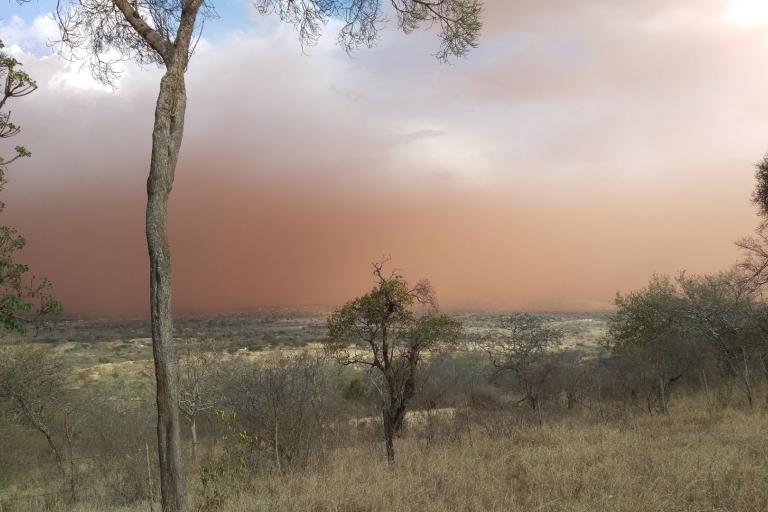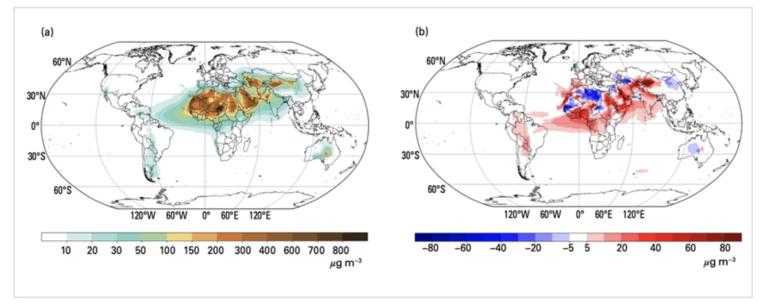WMO Airborne Dust Bulletin highlights present, future hotspots

The global average of annual mean dust surface concentrations in 2022 was slightly higher than that in 2021 due to increased emissions from west-central Africa, the Arabian Peninsula, the Iranian Plateau and north-western China. Spatially, the estimated peak annual mean dust surface concentration was in the Bodéle (Chad, in Africa), according to the Airborne Dust Bulletin 2022.
In 2022, hotspots with significantly higher dust concentrations were identified in Central and South America, most of Central Africa, Spain, the Red Sea, the Arabian Peninsula, the Arabian Sea, the Iranian Plateau, the Bay of Bengal, South Asia, the Tarim Basin in north-west China and the tropical Atlantic Ocean between West Africa and the Caribbean (Figure 1).

Every year, around 2,000 million tons of dust enters the atmosphere, darkening skies and harming air quality in regions that can be thousands of kilometers away, and affecting economies, ecosystems, weather and climate. Much of this is a natural process, but a large part of it is the result of poor water and land management.
Monitoring and forecasting accuracy has improved in recent years due to the progress of numerical models and observation systems. The WMO Sand and Dust Storm Warning Advisory and Assessment System (SDS-WAS), set up in 2007, strives to improve warnings through dedicated regional centres and combines research and operational work which is now being embedded in the international Early Warnings for All initiative.
“WMO is committed to tackling this major hazard. Sand and dust storms have impacts on health, on transport including aviation, ground transportation, road and railroad transportation and agriculture. This affects public health and safety and economies,” says WMO Secretary-General Prof. Petteri Taalas.
“The Early Warnings for All initiative contains an ambition to improve standard dust storm forecasting skills and warning services. We very promoting multi-hazard early warning service concepts to bring all hazards under one umbrella. And we also promoting impact-based forecasting which lies at the heart of improved warnings for sand and dust storms,” he says.
But more needs to be done, especially in the face of continuing environmental degradation and current and future climate change.
“The reports from the Intergovernmental Panel on Climate Change and WMO’s State of the Climate reports show show that human activities are having an impact on sand and dust storms. For example higher temperatures, drought and higher evaporation lead to lower soil moisture. Combined with poor land management, this is conducive to more sand and dust storms,” says Prof. Taalas.
Hotspots
Over the last decades, the Middle East region, where the Asian, African and European continents connect, has been suffering from “alarming” desertification processes and dust events, says the Bulletin. Intensive water withdrawals and increasing pressure on hydrological resources compound the challenges of an arid climate. The most significant hotspots in the growing trend of increased dust emissions are located along parts of the Afghanistan-Pakistan border, parts of the Islamic Republic of Iran, the Mesopotamian Plain in Iraq, eastern Syrian Arab Republic, the lower reaches of the Tigris and Euphrates rivers close to the Persian Gulf, according to aerosol satellite observations.
The regions that are most vulnerable to long-range transport of dust are: the northern tropical Atlantic Ocean between West Africa and the Caribbean; South America; the Mediterranean Sea; the Arabian Sea; the Bay of Bengal; central-eastern China; the Korean Peninsula and Japan.
In 2022, the transatlantic transport of African dust invaded the entire Caribbean Sea region and there have been frequent incursions this year.
Hazards in the Pan-American region
The report was released for Latin America and Caribbean Climate Week from 23 to 30 October and for the Forum of Ministers of Environment of Latin America and the Caribbean 24-26 October. Both events take place in Panama City and seek to discuss climate solutions ahead of COP28 in Dubai in December 2023.
It includes details of a new comprehensive review of dust hazards for the Americas, compiled by 28 experts in the WMO Sand and Dust Storm Advisory and Assessment Pan-American Node. A map of dust vulnerability focuses on health and safety effects, to support decision-makers.
Dust storms impact aviation and road transport; they reduce the performance of solar power plants and spread human pathogens, all of which negatively affect local and regional economies. The loss of soil nutrients costs agriculture more than US$ 8 billion dollars every year in the Pan-American region.
Exposure to dust particles has been associated with adverse health effects, including heart attacks, cardiovascular mortality, lung cancer and Valley fever in USA.

Interaction with climate change
The Airborne Dust Bulletin highlights the need for further research into future interactions between sand and dust storms and climate change as well as accompanying changes in the global atmospheric circulation and precipitation patterns.
Recent research has assessed potential changes in global dust emissions according to different climate warming scenarios. The difference between the base years (2015–2024) and the future years (2091–2100) for three different scenarios shows that dust storm emissions are predicted to increase significantly at the end of this century as strong warming progresses from the Gobi and Taklamakan deserts in eastern Asia to central Asia (Figure 3).
In the Gobi Desert and central Asia, the decrease in snow cover and increase in surface winds due to warming is predicted to cause an increase in dust storm emissions during the month of March.
In the Sahara, the effects of global warming may not be as pronounced as in parts of Asia, partly due to the missing snow cover in the Sahara.

(a) Base period (2015−2024) average SDS emissions for all experiments (25 members). (b)−(d) Ratio between the base period (2015−2024) and future (2091−2100) average SDS emissions in the (b) SSP1-1.9, (c) SSP2-4.5, and (d) SSP5-8.5 scenarios. The average of five ensemble members is shown for each scenario. Blue colours indicate decreased emissions from the base period, while red colours indicate increased emissions from the base period. Shaded areas indicate statistically significant regions (p < 0.05 in t-test).
WMO Response
The Bulletin highlights how WMO is responding to the many challenges. The Sand and Dust Storm Warning Advisory and Assessment System (SDS-WAS) seeks to provide timely and high-quality sand and dust storm forecasts, observations and knowledge to users.
It operates as an international hub of researchers, operational centres and end-users, and is organized through regional activity nodes, which are coordinated and implemented by the associated Regional Centre.
At present, there are four SDS-WAS research Regional Nodes:
- The Northern Africa, the Middle East and Europe (NAMEE) with a Centre in Barcelona, Spain.
- The Asian Node with a Centre in Beijing, China.
- The Pan-American Node with a Centre in Bridgetown, Barbados.
- The Gulf Cooperation Council (GCC) with a Centre in Jeddah, Saudi Arabia.
WMO efforts on the provision of sand and dust storms information are recognised at UN level. WMO is leading the Forecasting and Early Warning activities within the UN Coalition for Combating Sand and Dust Storms.
WMO will continue to work with partners Increasing understanding on the impacts of this natural hazard and to provide accurate information for its mitigation.
The World Meteorological Organization (WMO) is a specialized agency of the United Nations responsible for promoting international cooperation in atmospheric science and meteorology.
WMO monitors weather, climate, and water resources and provides support to its Members in forecasting and disaster mitigation. The organization is committed to advancing scientific knowledge and improving public safety and well-being through its work.
For further information, please contact:
- Clare Nullis WMO media officer cnullis@wmo.int +41 79 709 13 97
- WMO Strategic Communication Office Media Contact media@wmo.int

